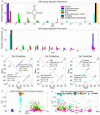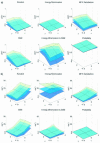Paradigms for computational nucleic acid design
- PMID: 14990744
- PMCID: PMC390280
- DOI: 10.1093/nar/gkh291
Paradigms for computational nucleic acid design
Abstract
The design of DNA and RNA sequences is critical for many endeavors, from DNA nanotechnology, to PCR-based applications, to DNA hybridization arrays. Results in the literature rely on a wide variety of design criteria adapted to the particular requirements of each application. Using an extensively studied thermodynamic model, we perform a detailed study of several criteria for designing sequences intended to adopt a target secondary structure. We conclude that superior design methods should explicitly implement both a positive design paradigm (optimize affinity for the target structure) and a negative design paradigm (optimize specificity for the target structure). The commonly used approaches of sequence symmetry minimization and minimum free-energy satisfaction primarily implement negative design and can be strengthened by introducing a positive design component. Surprisingly, our findings hold for a wide range of secondary structures and are robust to modest perturbation of the thermodynamic parameters used for evaluating sequence quality, suggesting the feasibility and ongoing utility of a unified approach to nucleic acid design as parameter sets are refined further. Finally, we observe that designing for thermodynamic stability does not determine folding kinetics, emphasizing the opportunity for extending design criteria to target kinetic features of the energy landscape.
Figures






Similar articles
-
Prediction and design of DNA and RNA structures.N Biotechnol. 2010 Jul 31;27(3):184-93. doi: 10.1016/j.nbt.2010.02.012. Epub 2010 Mar 1. N Biotechnol. 2010. PMID: 20193785 Review.
-
A thermodynamic approach to designing structure-free combinatorial DNA word sets.Nucleic Acids Res. 2005 Sep 2;33(15):4965-77. doi: 10.1093/nar/gki812. Print 2005. Nucleic Acids Res. 2005. PMID: 16284197 Free PMC article.
-
A statistical analysis of RNA folding algorithms through thermodynamic parameter perturbation.Nucleic Acids Res. 2005 Jan 26;33(2):519-24. doi: 10.1093/nar/gkh983. Print 2005. Nucleic Acids Res. 2005. PMID: 15673712 Free PMC article.
-
Secondary structure prediction of interacting RNA molecules.J Mol Biol. 2005 Feb 4;345(5):987-1001. doi: 10.1016/j.jmb.2004.10.082. Epub 2004 Dec 16. J Mol Biol. 2005. PMID: 15644199
-
Prediction of RNA secondary structure by free energy minimization.Curr Opin Struct Biol. 2006 Jun;16(3):270-8. doi: 10.1016/j.sbi.2006.05.010. Epub 2006 May 19. Curr Opin Struct Biol. 2006. PMID: 16713706 Review.
Cited by
-
DNA tetrominoes: the construction of DNA nanostructures using self-organised heterogeneous deoxyribonucleic acids shapes.PLoS One. 2015 Aug 10;10(8):e0134520. doi: 10.1371/journal.pone.0134520. eCollection 2015. PLoS One. 2015. PMID: 26258940 Free PMC article.
-
Computational RNA secondary structure design: empirical complexity and improved methods.BMC Bioinformatics. 2007 Jan 31;8:34. doi: 10.1186/1471-2105-8-34. BMC Bioinformatics. 2007. PMID: 17266771 Free PMC article.
-
Computational design and experimental verification of pseudoknotted ribozymes.RNA. 2023 Jun;29(6):764-776. doi: 10.1261/rna.079148.122. Epub 2023 Mar 3. RNA. 2023. PMID: 36868786 Free PMC article.
-
Topological constraints in nucleic acid hybridization kinetics.Nucleic Acids Res. 2005 Jul 25;33(13):4090-5. doi: 10.1093/nar/gki721. Print 2005. Nucleic Acids Res. 2005. PMID: 16043632 Free PMC article.
-
Generation of DNA oligomers with similar chemical kinetics via in-silico optimization.Commun Chem. 2023 Oct 18;6(1):226. doi: 10.1038/s42004-023-01026-w. Commun Chem. 2023. PMID: 37853171 Free PMC article.
References
-
- Seeman N.C. (1982) Nucleic acid junctions and lattices. J. Theor. Biol., 99, 237–247. - PubMed
-
- Seeman N.C. (1999) DNA engineering and its application to nanotechnology. Trends Biotechnol., 17, 437–443. - PubMed
-
- Winfree E., Liu,F., Wenzler,L.A. and Seeman,N.C. (1998) Design and self-assembly of two-dimensional DNA crystals. Nature, 394, 539–544. - PubMed
-
- Kallenbach R.K., Ma,R.-I. and Seeman,N.C. (1983) An immobile nucleic acid junction constructed from oligonucleotides. Nature, 305, 829–831.
-
- Chen J. and Seeman,N.C. (1991) The synthesis from DNAs of a molecule with the connectivity of a cube. Nature, 350, 631–633. - PubMed
Publication types
MeSH terms
Substances
LinkOut - more resources
Full Text Sources
Other Literature Sources

